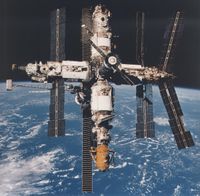مير (محطة فضائية)
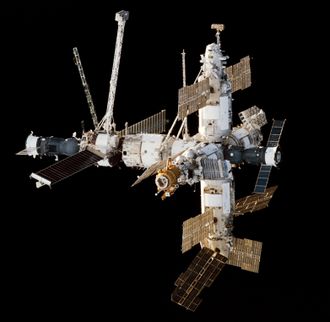 | |
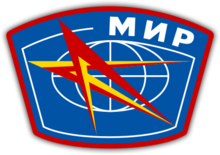 Mir insignia | |
| Station statistics | |
|---|---|
| COSPAR ID | 1986-017A |
| Call sign | Mir |
| الطاقم | 3 |
| الإطلاق | 20 February 1986 – 23 April 1996 |
| منصة الاطلاق | LC-200/39, and LC-81/23, Baikonur Cosmodrome LC-39A Kennedy Space Center |
| معاودة الدخول | 23 March 2001 05:59 UTC |
| الكتلة | 129,700 kg (285,940 lb) |
| الطول | 19 m (62.3 ft) from core module to Kvant-1 |
| العرض | 31 m (101.7 ft) from Priroda to docking module |
| الارتفاع | 27.5 m (90.2 ft) from Kvant-2 to Spektr |
| الحجم المضغوط | 350 m³ |
| ضغط الغلاف الجوي | c.101.3 kPa (29.91 inHg, 1 atm) |
| Perigee | 354 km (189 nmi) AMSL |
| Apogee | 374 km (216 nmi) AMSL |
| Orbital inclination | 51.6 degrees |
| السرعة المدارية | 7.7 km/s (27,700 km/h, 17,200 mph) |
| الفترة الدورية | 91.9 minutes |
| الدورات باليوم | 15.7 |
| الأيام في المدار | خطأ في التعبير: عامل < غير متوقع. days (15 years and 31 days) |
| الأيام المأهولة | 4,592 days |
| عدد المدارات | 86,331 |
| الإحصائيات في 23 March 2001 (unless noted otherwise) المراجع: [1][2][3][4][5][6][7][8][9][10][11][12] | |
| التشكيل | |
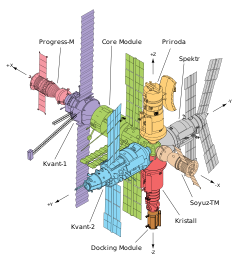 Station elements as of May 1996 | |
محطة الفضاء مير Mir وبالروسية (Мир) ويعني العالم أو السلام، هو اسم محطة الفضاء الروسية التي تعتبر فخر الصناعات الفضائية الروسية. سجلت المحطة الفضائية مير رقماً قياسياً في أطول مدة بقاء لإنسان في الفضاء حيث بقيت في الخدمة أكثر من 10 سنوات، ويقبت تحلق بالفضاء قرابة 15 عام حتى عام 2001.
تاريخها
في عام 1986 بدأ السوفيت تشغيل محطة مير الفضائية، وهي أول محطة تستخدم تصميم المركبات الانفصالية. واستطاعوا تطوير نظام نقل اقتصادي يمكن الاعتماد عليه للوصول للمحطة، مما مكنهم من نقل المؤن والمعدات والبدلاء لأفراد الطاقم. وفي أعقاب انهيار الاتحاد السوفييتي في عام 1991، تولت روسيا مهمة تشغيل محطة مير. كانت المحطة مير تدور حول الأرض مرة كل 90 دقيقة على ارتفاع 200 ميل فوق سطحها. وقد قدمت اسهامات كبيرة في مجال البحث الفضائي طوال فترة خدمتها.
تعرضت مير لعدة اعطال فنية وحوادث كان اسوأها حادث التصادم الذي وقع في يونيو عام 1998 حينما اصدمت مركبة شحن فضائية بالمحطة والحقت بها اضرار جسيمة وقام الملاحون ورواد الفضاء الروس بالسير في الفضاء لإصلاح الأعطال الكبيرة التي تعرضت لها كل من المحطة ومركبة الشحن الفضائية.
بنية المحطة
التجميع

Pressurised modules
In its completed configuration, the space station consisted of seven different modules, each launched into orbit separately over a period of ten years by either Proton-K rockets or مكوك فضاء أتلانتس.
| Module | Expedition | Launch date | Launch system | Nation | Isolated View | Station View |
|---|---|---|---|---|---|---|
| Mir Core Module (Core Module) |
N/A | 19 February 1986 | Proton-K | Soviet Union | ||
| The base block for the entire Mir complex, the core module, or DOS-7, provided the main living quarters for resident crews and contained environmental systems, early attitude control systems and the station's main engines. The module was based on hardware developed as part of the Salyut programme, and consisted of a stepped-cylinder main compartment and a spherical 'node' module, which served as an airlock and provided ports to which four of the station's expansion modules were berthed and to which a Soyuz or Progress spacecraft could dock. The module's aft port served as the berthing location for Kvant-1.[14] | ||||||
| Kvant-1 (Astrophysics Module) |
EO-2 | 31 March 1987 | Proton-K | Soviet Union | 
|

|
| The first expansion module to be launched, Kvant-1 consisted of two pressurised working compartments and one unpressurised experiment compartment. Scientific equipment included an X-ray telescope, an ultraviolet telescope, a wide-angle camera, high-energy X-ray experiments, an X-ray/gamma ray detector, and the Svetlana electrophoresis unit. The module also carried six gyrodynes for attitude control, in addition to life support systems including an Elektron oxygen generator and a Vozdukh carbon dioxide scrubber.[14] | ||||||
| Kvant-2 (Augmentation Module) |
EO-5 | 26 November 1989 | Proton-K | Soviet Union | 
| |
| The first TKS based module, Kvant-2, was divided into three compartments: an EVA airlock, an instrument/cargo compartment (which could function as a backup airlock), and an instrument/experiment compartment. The module also carried a Soviet version of the Manned Maneuvering Unit for the Orlan space suit, referred to as Ikar, a system for regenerating water from urine, a shower, the Rodnik water storage system and six gyrodynes to augment those already located in Kvant-1. Scientific equipment included a high-resolution camera, spectrometers, X-ray sensors, the Volna 2 fluid flow experiment, and the Inkubator-2 unit, which was used for hatching and raising quail.[14] | ||||||
| Kristall (Technology Module) |
EO-6 | 31 May 1990 | Proton-K | Soviet Union | 
| |
| Kristall, the fourth module, consisted of two main sections. The first was largely used for materials processing (via various processing furnaces), astronomical observations, and a biotechnology experiment utilising the Aniur electrophoresis unit. The second section was a docking compartment which featured two APAS-89 docking ports initially intended for use with the Buran programme and eventually used during the Shuttle-Mir programme. The docking compartment also contained the Priroda 5 camera used for Earth resources experiments. Kristall also carried six gyrodines for attitude control to augment those already on the station, and two collapsible solar arrays.[14] | ||||||
| Spektr (Power Module) |
EO-18 | 20 May 1995 | Proton-K | Russia | 
|

|
| Spektr was the first of the three modules launched during the Shuttle-Mir programme; it served as the living quarters for American astronauts and housed NASA-sponsored experiments. The module was designed for remote observation of Earth's environment and contained atmospheric and surface research equipment. Additionally, it featured four solar arrays which generated approximately half of the station's electrical power. The module also featured a science airlock to expose experiments to the vacuum of space selectively. Spektr was rendered unusable following the collision with Progress M-34 in 1997 which damaged the module, exposing it directly to the vacuum of space.[15] | ||||||
| Docking Module | EO-20 | 15 November 1995 | مكوك فضاء أتلانتس (STS-74) |
US | 
|

|
| The docking module was designed to help simplify Space Shuttle dockings to Mir. Before the first shuttle docking mission (STS-71), the Kristall module had to be tediously moved to ensure sufficient clearance between Atlantis and Mir's solar arrays. With the addition of the docking module, enough clearance was provided without the need to relocate Kristall. It had two identical APAS-89 docking ports, one attached to the distal port of Kristall with the other available for shuttle docking.[15] | ||||||
| Priroda (Earth Sensing Module) |
EO-21 | 26 April 1996 | Proton-K | Russia | 
|

|
| The seventh and final Mir module, Priroda's primary purpose was to conduct Earth resource experiments through remote sensing and to develop and verify remote sensing methods. The module's experiments were provided by twelve different nations, and covered microwave, visible, near infrared, and infrared spectral regions using both passive and active sounding methods. The module possessed both pressurised and unpressurised segments, and featured a large, externally mounted synthetic aperture radar dish.[15] | ||||||
Unpressurised elements
الامداد بالطاقة
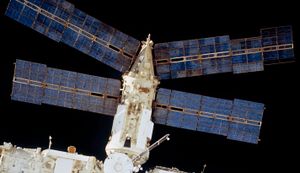
Orbit control
Microgravity
التعاون الدولي
Shuttle–Mir programme

الحياة على متنها

التريض

النوم في الفضاء
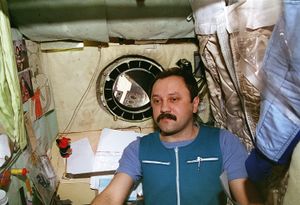
عمليات المحطة
التجريدات
Early existence
Third start
Post-Soviet period

Shuttle–Mir
Final days and deorbit

Visiting spacecraft
Mission control centre

نهايتها
بسبب الأضرار والمشاكل الفنية العديدة التي تعرضت لها المحطة مير وبسبب نقص ميزانية نفقاتها، قررت وكالة الفضاء الفدرالية الروسية التخلي عن المحطة وتحطيمها، وقد تم تحويل التحكم بالمحطة إلى نظام التوجيه الآلي وأطلق العنان لعمل الحاسوب الآلي على ظهر المحطة، ثم تم تحطيمها ذلك كم خلال تفكيكها واسقاطها في المحيط الهادي في 23 مارس 2001.
Safety aspects
Aging systems and atmosphere
حوادث
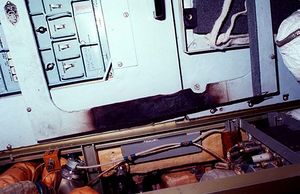
انظر أيضا
- برنامج الفضاء الروسي
- وكالة الفضاء الاتحادية الروسية
- وكالة الفضاء الأمريكية (ناسا)
- محطة الفضاء الدولية
- مير-2
الهامش
- ^ "Mir-Orbit Data". Heavens-Above.com. 23 March 2001. Retrieved 30 June 2009.
- ^ "Mir FAQ - Facts and history". European Space Agency. 21 February 2001. Retrieved 19 August 2010.
- ^ "Mir Space Station - Mission Status Center". Spaceflight Now. 23 March 2001. Retrieved 19 August 2010.
- ^ "NASA - NSSDC - Spacecraft - Details - Mir". NASA. 23 July 2010. Retrieved 22 August 2010.
- ^ "Soviet/Russian space programmes Q&A". NASASpaceflight.com. Retrieved 22 August 2010.
- ^ خطأ استشهاد: وسم
<ref>غير صحيح؛ لا نص تم توفيره للمراجع المسماةMirBIS - ^ خطأ استشهاد: وسم
<ref>غير صحيح؛ لا نص تم توفيره للمراجع المسماةFinalBIS - ^ خطأ استشهاد: وسم
<ref>غير صحيح؛ لا نص تم توفيره للمراجع المسماةOrbitCalc - ^ "Mir Space Station Observing". Satobs.org. 28 March 2001. Retrieved 12 September 2010.
- ^ Mark Wade (4 September 2010). "Baikonur LC200/39". Encyclopedia Astronautica. Archived from the original on 24 August 2010. Retrieved 25 September 2010.
{{cite web}}: Unknown parameter|deadurl=ignored (|url-status=suggested) (help) - ^ Mark Wade (4 September 2010). "Baikonur LC81/23". Encyclopedia Astronautica. Archived from the original on 1 February 2010. Retrieved 25 September 2010.
{{cite web}}: Unknown parameter|deadurl=ignored (|url-status=suggested) (help) - ^ Macatangay A.V.; Perry J.L. (22 January 2007). "Cabin Air Quality On Board Mir and the International Space Station—A Comparison" (PDF). Johnson Space Center & Marshall Spaceflight Center: NASA: 2.
{{cite journal}}: Cite journal requires|journal=(help); Unknown parameter|lastauthoramp=ignored (|name-list-style=suggested) (help) - ^ Joel W. Powell; Lee Brandon-Cremer (2011) [1992]. Space Shuttle Almanac. ISBN 0-9696313-0-8. Retrieved 23 August 2011.
{{cite book}}: Unknown parameter|lastauthoramp=ignored (|name-list-style=suggested) (help) - ^ أ ب ت ث David S. F. Portree (March 1995). Mir Hardware Heritage. NASA.
- ^ أ ب ت خطأ استشهاد: وسم
<ref>غير صحيح؛ لا نص تم توفيره للمراجع المسماةSSSM
وصلات خارجية
- [1] NASA animation of Mir's deorbit
- [2] Mir Diary
- [3] Diagrams, pictures and background info
- [4] Information on problems aboard Mir
- [5] Shuttle-Mir: Phase 1 Program Joint Report
- [6] Mir Space Station (NASA)
| سبقه Salyut 7 |
Mir 1986–2001 |
تبعه Mir-2 as the ROS in the ISS |
قالب:Orbital launches in 1986 قالب:Mir modules قالب:Manned Mir flight قالب:Mir expeditions قالب:Shuttle-Mir
- CS1 errors: unsupported parameter
- Articles with hatnote templates targeting a nonexistent page
- Portal templates with default image
- مير
- محطات فضائية
- مركبات فضائية مأهولة
- Spacecraft which reentered in 2001
- 1986 في ارتياد الفضاء
- Manned space program of the Soviet Union
- Manned space program of Russia
- Spacecraft launched in 1986
- مقالات تحتوي مقاطع ڤيديو
- فضاء

